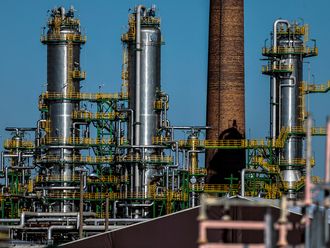Houston: Saudi Arabia and Russia, the architects of an oil production cut that has stabilised prices, presented a united front on compliance just as rising US inventories have sparked doubts about the Organisation of the Petroleum Exporting Countries (Opec) and non-Opec deal.
Khalid Al Falih, the Saudi energy minister, acknowledged that global crude inventories aren’t draining as quickly as he expected, opening the door for an extension of the production cuts into the second half of the year. The potential rollover is a subtle yet significant shift from just six weeks ago, when the minister said that an extension probably wouldn’t be needed.
Al Falih’s concern about the slow pace of stockpile reductions was echoed by Suhail Al Mazrouei, the oil minister for the UAE.
Since the Opec and some of its rivals, including Russia, agreed to cut output in late 2016, oil prices have stabilised at around $50-$55 (Dh183-Dh202) a barrel, up from $45-$50 a barrel before. Yet, prices are struggling to rise further as US crude stocks increased to record levels.
With the market starting to believe the cuts were backfiring by reviving US oil production, Al Falih and his Russian counterpart, Alexander Novak, called a news conference in Houston after a round of meetings to offer a united front, and insist the cuts will work.
‘Low expectations’
“The market had low expectations, which we have exceeded by a large degree,” Al Falih said about the compliance level. “We are definitely on the right track and are picking up speed in terms of delivery.”
Novak, who personally negotiated the cuts with Al Falih in meetings and late night phone calls last year, said that compliance with the curbs will improve in the next three months. Novak promised that Moscow will cut production further. The Iraqi oil minister and Mexico’s deputy energy minister, alongside the Opec secretary general, joined the news conference, repeating similar upbeat messages.
For all the theatrics on the sidelines of the CERAWeek by IHS Markit conference, which each year gathers thousands of oil executives, bankers and investors in Houston, Opec and non-Opec ministers appear to be concerned that their cuts are stoking a new shale boom. Novak said he and the other ministers discussed compliance, the possibility of an extension, and US production in their meetings this week.
Lifted forecast
The US Energy Information Administration (EIA) on Tuesday lifted its forecast for US crude oil output, saying next year it will top the all-time record set in 1970. Output will average 9.21 million barrels a day in 2017, up from 8.98 million projected in February, the agency said. For 2018, US production will rise to an average 9.73 million barrels a day, up from 9.53 million barrels projected last month, and it will exceed 10 million barrels a day in December 2018.
The nation’s crude stockpiles expanded by 11.6 million barrels last week, the ninth consecutive gain, according to people familiar with data from the American Petroleum Institute Tuesday. The EIA will publish inventory data on Wednesday that is also forecast to show an increase.
“The green shoots in the US are growing too fast,” Al Falih said earlier at a plenary session of the Houston meeting, prompting laughs in the audience. Soon afterward, the head of ConocoPhillips, Ryan Lance, quipped US shale wasn’t just green shoots, but actual “trees”.
Saudi Arabia also put a price to continue its newfound cooperation with Russia and other oil producers. While Al Falih didn’t rule out extending the duration of the supply cuts, he insisted the kingdom wouldn’t act alone.
“It is not going to be fair or acceptable that some countries will carry the burden for all,” he said, referring to how Saudi Arabia is cutting more than it promised. “We’ve been willing to do it for the front end but we expect our friends and partners to pick up the slack as we move forward.”
Russia and Iraq, the two largest producers involved in the deal after Saudi Arabia, have so far reduced output less than promised. Jabbar Al Luaibi, Iraq oil minister, said there were “some differences here and there” about the cuts, but that Baghdad was “resolved 100 per cent to solve those problems.”
Russia gave assurances that it will cut another 40,000 barrels a day from supply this month, Al Falih said. That would put the largest non-Opec producer participating in the agreement about halfway to the 300,000 barrel-a-day cut that it pledged to implement by April or May.












